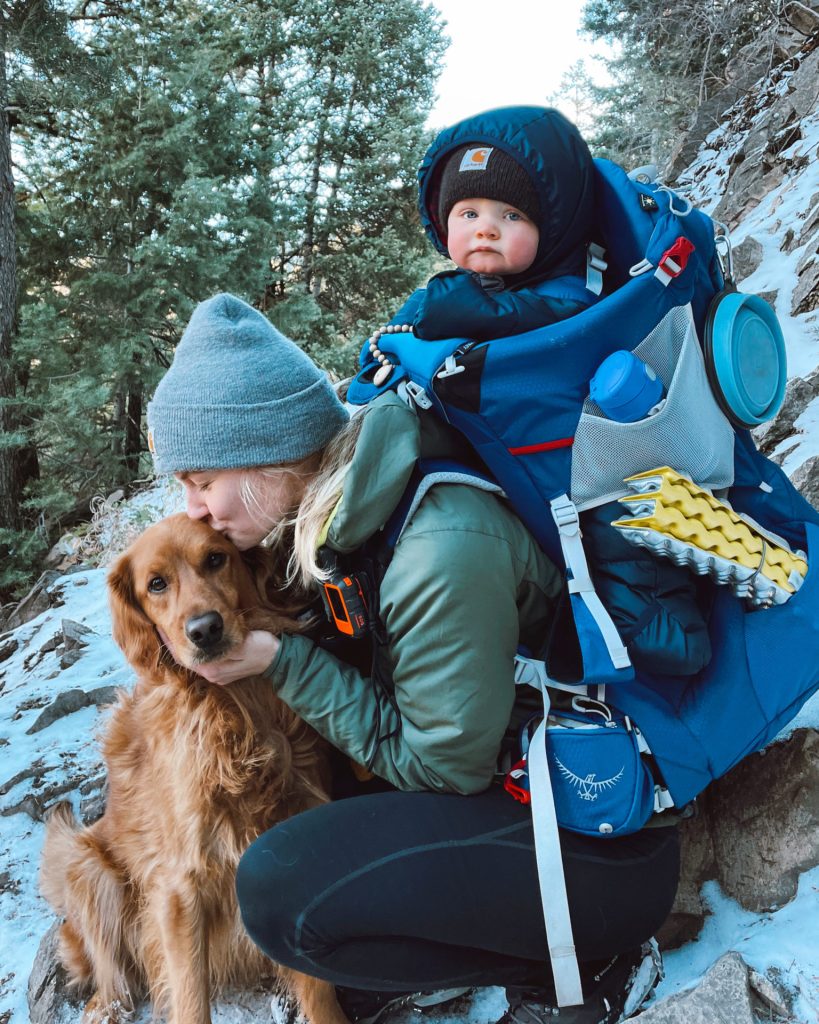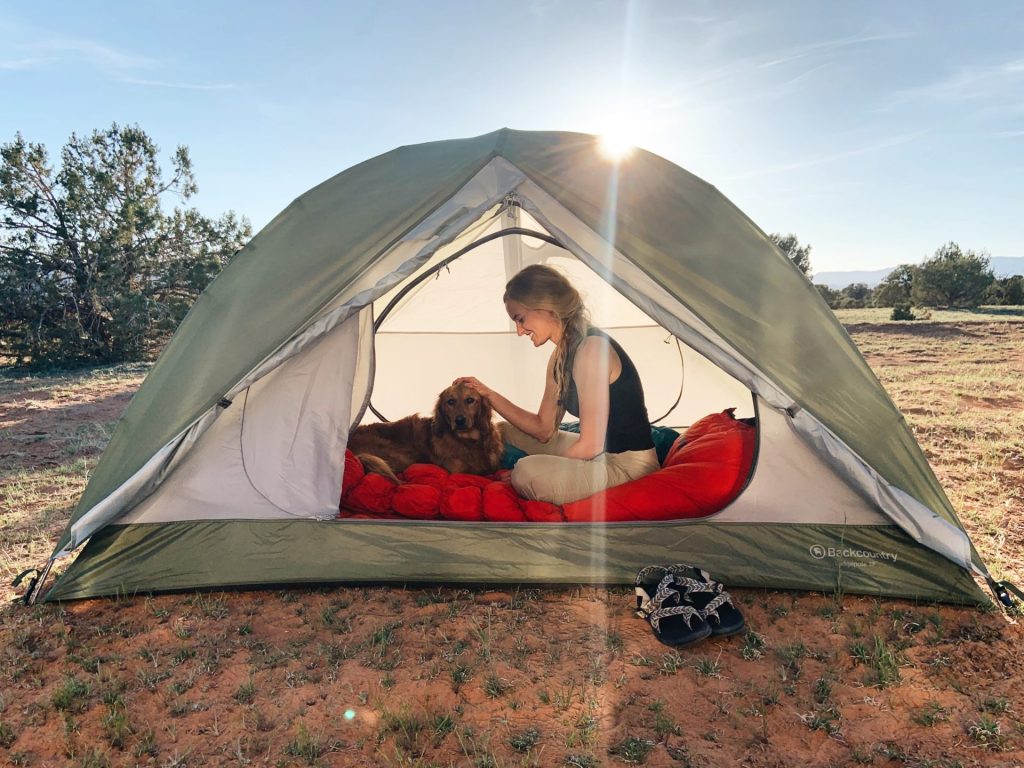Looking for the best dog hiking backpack? Here’s why I love the Ruffwear Approach Pack for longer hikes and backpacking trips—plus tips on fitting, packing, and trail use.

If you’ve ever hit the trail with your dog for a longer hike or backpacking trip, you know how much stuff they need—food, water, poop bags, maybe even a little jacket or booties depending on the weather. It adds up fast, and instead of stuffing all their gear into my already full pack, I started using a dog hiking backpack—and it’s honestly been great for me and my dog!
We don’t use it on every hike (definitely not on quick, casual walks), but for longer days out or when we’re backpacking overnight, it’s super helpful. My dog carries his own food, water, collapsible bowl, and sometimes even his leash. It makes things easier for me and gives him a job, which he seems to love.
In this post, I’ll walk you through everything I’ve learned about using a dog hiking backpack: how to fit it properly so it’s comfortable and safe, what I usually pack in it, and why I personally love the Ruffwear Approach Pack. We’ve used it for years now, and it’s held up so well through all kinds of terrain and weather. Whether you’re new to hiking with your dog or looking to upgrade your setup, this guide will help you hit the trail a little more prepared.
*The links shared in this post may be affiliate links meaning I make a small commission off of your purchase (with no extra cost to you). This allows me to continue to create free content for my readers. Thank you for your continued support!
Why Use a Dog Hiking Backpack?
I didn’t use a dog hiking backpack when we first started hiking with our pup, but once we started doing longer hikes and overnight trips, I quickly realized how helpful it could be. Between his food, treats, poop bags, water, and a collapsible bowl, it just made sense for him to carry some of his own gear—especially when my backpack was already packed full with stuff for the kids and myself.
I even have him carry some of our gear which is super helpful!
I love using a dog hiking backpack because it makes things more manageable for me, but also because my dog genuinely seems to enjoy having a job. He gets excited when I pull out his pack because he knows we’re going on an adventure. We don’t use it for every outing—short hikes or super hot days are usually a no—but for anything longer than a few miles or if we’re backpacking, it’s 100% worth it. It keeps the load balanced, frees up space in my pack, and honestly, it’s just fun seeing him strut down the trail looking like a little trail pro.
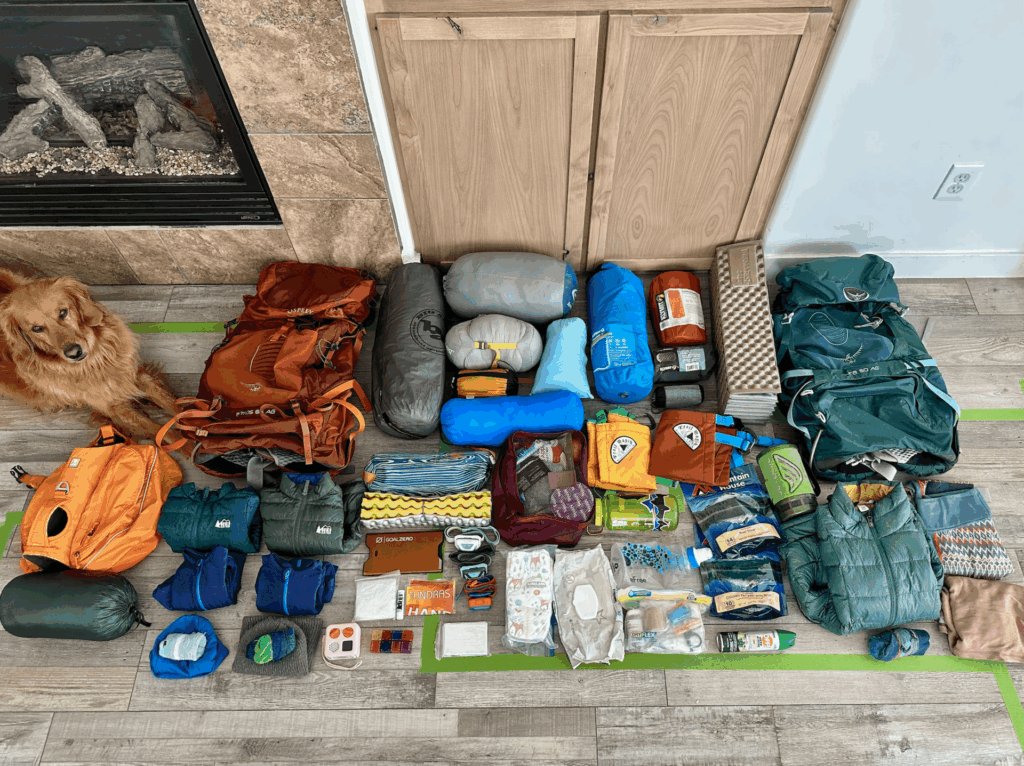
My Favorite Dog Hiking Backpack – THe Ruffwear Approach
After researching dog hiking backpacks, I purchased the Ruffwear Approach and haven’t looked back. It’s sturdy, well-designed, and comes in multiple sizes—so it’s easy to get a great fit no matter your dog’s breed or build.The saddlebags are streamlined but roomy, and I love that the pack has a built-in harness with a solid handle and leash attachment. It’s super functional without being bulky or annoying for my dog to wear.
One of the biggest reasons I went with the Approach is how well it balances weight. The saddlebags are angled in a way that keeps the pack from shifting too much, even when my dog is scrambling over rocks or jumping over logs. The materials are tough (ours has been through mud, snow, and brambles) and it’s held up really well over years of use. It’s not the cheapest option out there, but if you’re hiking or backpacking regularly with your dog, I think it’s totally worth the investment.
How to Fit the Pack Properly On Your Dog
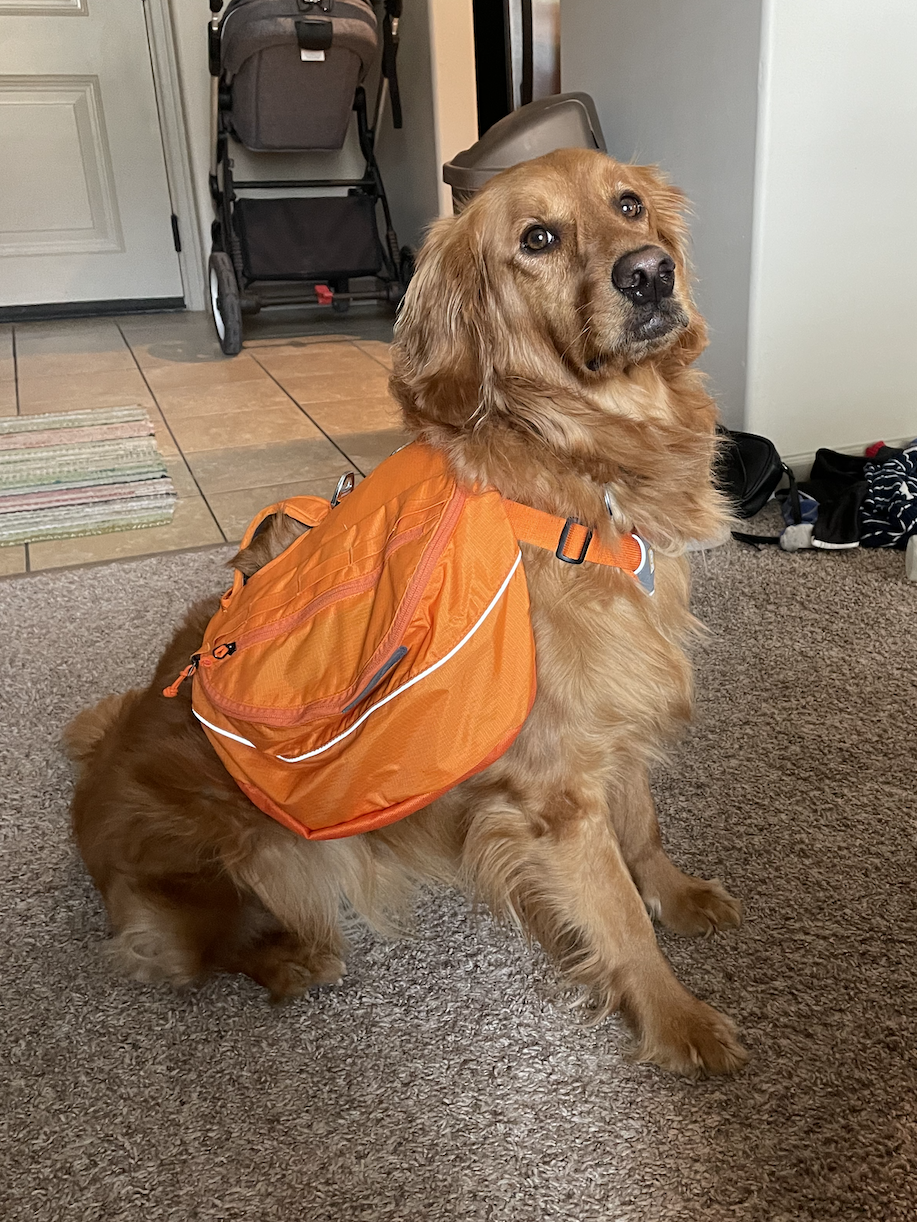
Getting the right fit makes all the difference when it comes to using a dog hiking backpack. A good fit keeps your dog comfortable and prevents the pack from sliding around or causing chafing on the trail. Here’s how I fit the Ruffwear Approach Pack on my dog step by step:
1. Measure Your Dog’s Girth
Start by measuring around the widest part of your dog’s ribcage—this is the girth measurement Ruffwear uses to determine sizing. Check their size chart and choose the size that matches best. If your dog is in between sizes, I recommend sizing up so you have more room to adjust.
2. Adjust the Straps Before Loading
Before you even put anything in the pack, clip it onto your dog and start adjusting the straps. There are several points of adjustment (under the chest and around the belly) so take your time to make it snug but not tight. I like to make sure I can comfortably slip two fingers under each strap.
3. Check the Pack Position
The saddlebags should sit high and evenly on both sides, not sagging or slipping back toward their hips. If the pack is lopsided or shifting as they move, it’s either not tight enough or not balanced (more on that in the next section).
4. Do a Test Walk
Let your dog wear the empty pack around the house or on a short walk to get used to the feel of it. This also gives you a chance to check for any rubbing or hotspots before you add weight. Once they’re moving comfortably, you’re ready to load it up.
What My Dog Carries in his Backpack
One of the things I love most about using a dog pack is having my dog carry his own gear—and sometimes a little bit of mine too. As long as I keep the total weight under the recommended limit (which is generally about 25% of your dog’s body weight—so around 12–13 lbs for my 50 lb dog), it’s a huge help.
He always carries the basics: his food, collapsible bowl, poop bags, and a small towel or wipe for muddy paws. But I also use the pack to offload a few bulkier items that don’t weigh much but take up a ton of space in my own pack—like inflatable pillows, wipes, and even a few diapers if we’re backpacking with the kids. I’ve had him carry an extra leash or our lightweight dog jacket too.
The key is keeping the weight balanced between both sides of the pack so it doesn’t shift while he’s walking. If I’m packing something heavier like water, I’ll try to even it out with snacks or soft gear on the other side. It might take a little trial and error to find the right combo, but once you do, it’s honestly amazing how much it helps free up space in your own pack.
Pros and Cons of the Ruffwear Approach Dog Hiking Backpack
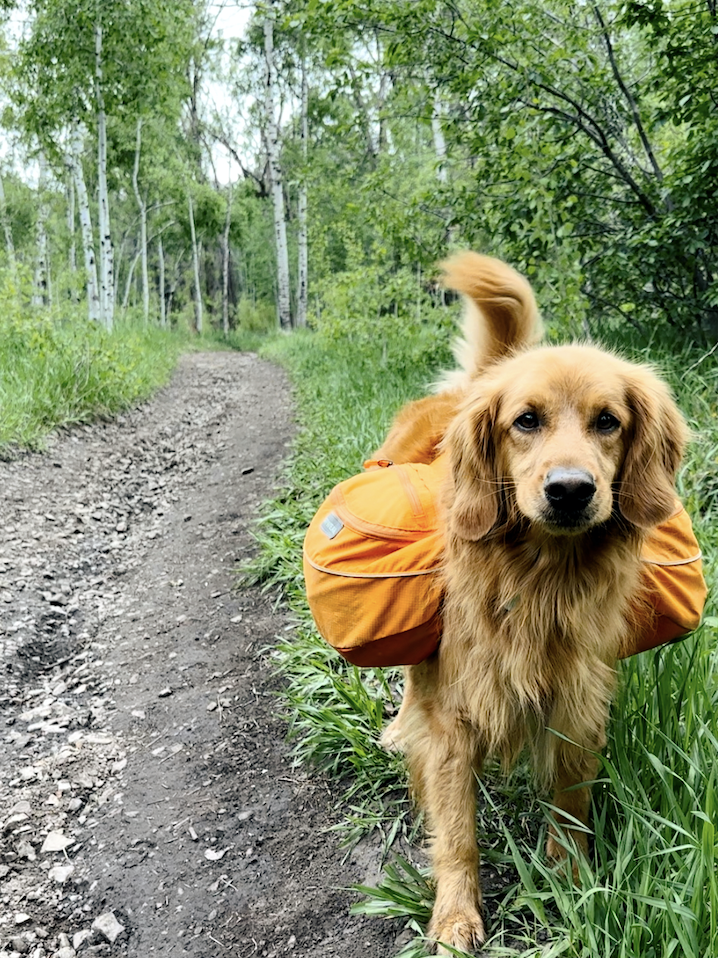
After using the Ruffwear Approach Pack on tons of hikes and backpacking trips, I’ve got a pretty good sense of what it does well—and where it could be improved. Overall, I really love this pack and would recommend it to anyone who hikes regularly with their dog, but here’s the honest breakdown:
Pros ✅
- Durable and Trail-Ready: This thing is tough. We’ve scraped through brush, splashed through streams, and even done some snow hiking, and the pack still looks great.
- Built-In Harness: I love that it has a handle on top and a solid leash attachment point. It gives me extra control when I need it, especially on tricky sections of trail.
- Balanced, Low-Profile Saddlebags: The design helps keep the weight close to the body, so it doesn’t flop around or tip to one side. My dog moves comfortably and naturally in it.
- Roomy but Streamlined: There’s plenty of space for everything he needs (and then some of my overflow!), without it feeling bulky or awkward.
Cons ❌
- Not Fully Removable Saddlebags: You can’t take the saddlebags off like you can with some other Ruffwear packs. Not a dealbreaker, but it means your dog wears the full setup even when stopped at camp.
- If you’re looking for a dog pack with removable saddlebags, the Ruffwear Palisades Pack is a great option. It’s saddlebags detach from the harness, allowing your dog to rest without carrying the full load when you stop at camp or take breaks. It can also be used just as a harness if you’re hiking places where your dog will need to be lifted up.
- No Waterproofing: The material is water-resistant, but not waterproof. I try to pack things in dry bags or Ziplocks just to be safe in wet weather.
- Pricey: Like most Ruffwear gear, it’s a bit of an investment—but for how well it’s held up, I think it’s worth every penny.
Tips for Hiking or Backpacking with a Dog Pack

Hitting the trail with your dog is one of my favorite ways to adventure—but adding a dog pack into the mix does take a little extra planning. Over the years, I’ve learned a few things that help make our hikes smoother, safer, and more fun for both of us.
For more detailed tips on backpacking with your dog—including gear recommendations, trail etiquette, and safety considerations—check out my full guide: Backpacking with a Dog – Everything You Need to Know.
Start Slow and Build Up
If your dog is new to wearing a pack, start with short walks around the neighborhood or park. Let them get used to the feel of it empty before adding any weight. Gradually increase the load and distance over time. This helps build their strength and confidence without overwhelming them.
Keep It Under 25% of Their Body Weight
As a general rule, dogs should carry no more than 25% of their body weight—including the pack itself. For my 50 lb dog, that’s about 12.5 lbs max. I usually stay well under that, especially on longer hikes or in hot weather. Always balance the weight evenly between both sides of the pack to prevent strain or chafing.
Watch for Signs of Fatigue or Discomfort
Dogs can’t tell us when something’s wrong, so it’s important to keep an eye on their behavior. If your dog starts lagging behind, panting excessively, or seems reluctant to keep going, it’s time for a break. Check for any signs of rubbing or irritation from the pack straps, and make sure their paws are in good shape—especially on rocky or hot terrain.
Pack Smart and Light
Let your dog carry their own essentials like food, water, a collapsible bowl, and waste bags. I also use my dog’s pack to offload some of my bulkier but lightweight items—like inflatable pillows or extra diapers for the kids. Just be mindful of the total weight and balance. Don’t exceed 25% of your dogs weight.
Practice Leave No Trace
Always pick up after your dog and pack out waste. If you’re in the backcountry, bury waste at least 6-8 inches deep and 200 feet away from water sources, trails, and campsites. Keeping the trails clean ensures they stay open and enjoyable for everyone.
If you enjoyed this post about The Best Dog Hiking Backpack, be sure to check out these posts:

